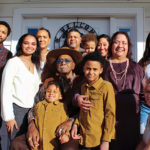
As churches celebrate Hispanic heritage, instead of merely committing to a single month, make it a year-round endeavor.
By Cesar Custodio
Hispanic Heritage Month, celebrated annually from September 15 to October 15, is a time to recognize and celebrate the rich culture, history, diversity, and contributions of the Hispanic culture. And pastors and church members can use this time to build close relationships with Hispanics in their church and community.
The Hispanic population continues to grow in the United States and has a significant influence. Hispanics contribute to every aspect of life, with over 60 million Hispanics living in the U.S., according to the 2020 Census. For many years, the Hispanic community has contributed considerably to history, arts, music, food, civil rights, leadership, government, and the diversity of our nation.
According to research conducted by Lifeway Research, in collaboration with the Billy Graham Evangelistic Association and Samaritan’s Purse, the Hispanic church is experiencing remarkable growth in the U.S. Most Hispanic Protestant churches (54%) have been established since 2000, including 32% founded in 2010 or later. And most people in the congregations are also new to the United States, with the majority being first-generation Americans (58%), born outside of the country. Within the church, Hispanics have taken an active role in missions, evangelism, and growing the local churches. Understanding these dynamics opens opportunities for others in the body of Christ to engage and support efforts to reach a population that sometimes seems unreachable because of language or cultural barriers.
Opportunities for connection
Hispanic Heritage Month offers a unique opportunity for churches seeking to foster unity within their congregations or reach out to Spanish-speaking communities. Beyond festivities and decorations, the true essence of celebrating Hispanic heritage lies in forging genuine connections and understanding. As all believers are called to be the church, we are called to be united and love one another. By emphasizing the importance of understanding differences, we can ensure this celebration becomes a transformative experience that bridges cultures and strengthens relationships. If your church includes Hispanic members or if you are trying to reach out to the Hispanic community, here are seven practical ways to help your church engage with Hispanic culture this month (and beyond).
“Hispanic Heritage Month offers a unique opportunity for churches seeking to foster unity within their congregations or reach out to Spanish-speaking communities.” — @cesarcustodiojr Click To Tweet1. Cultural workshops
Organize workshops that educate leaders and members about Hispanic culture, traditions, and history. This knowledge can foster empathy and create an environment of respect and understanding. These workshops can emphasize the importance of family and community in Hispanic culture and provide opportunities to discuss the strong bonds and support networks within Hispanic families and communities. Many Hispanic families have strong roots in their native country. Explore what these roots represent for them.
2. Multilingual services
Incorporate some Spanish elements into worship services, such as worship and Bible readings. Training leaders to seamlessly weave these elements into services can create unique and memorable worship experiences. You may find that worship songs have a Spanish version and introduce some parts of it to the worship service.
3. Guest speakers
Invite Hispanic speakers to share their experiences and insights during sermons or talks. Training leaders to engage in open conversations about Hispanic communities’ achievements and challenges can lead to a deeper understanding of cultural nuances and perspectives and how they can help the community grow and thrive spiritually.
4. Spanish classes
Spanish is a widely spoken language in the U.S., and bilingualism is a common feature of many Hispanic communities. Offer Spanish language classes or conversational groups to help church members communicate more effectively with Hispanic congregants. Learning a language is a tangible way to break down barriers and show appreciation for another culture. Many churches are already serving their communities with ESL (English as a Second Language) programs. And you can use these programs to connect church members with the people attending them.
“The most effective way to make ethnic minority families feel genuinely welcomed is by implementing a year-round plan for connecting with them.” — @cesarcustodiojr Click To Tweet5. Dining and community
Who doesn’t love food? You can explore the delicious and diverse world of Hispanic cuisine, including dishes like paella, empanadas, tacos, asados, and more. Mention the influence of Hispanic cuisine on American food culture and host potluck-style gatherings featuring Hispanic dishes. By encouraging members to prepare and share their favorite traditional foods, you create opportunities for cross-cultural connections.
6. Community outreach
Train church members and leaders to collaborate with local Hispanic organizations. Engaging in joint community service projects fosters unity and demonstrates commitment to making a positive impact. Latino families moving to your church neighborhood, present opportunities for the church to be part of their integration.
7. Storytelling and testimonies
Provide a platform for Hispanic church members to share their personal stories and testimonies. Training leaders to actively listen and create an environment of validation can strengthen bonds and develop a sense of belonging.
Hispanic Heritage Month offers churches a valuable opportunity to embrace diversity and forge stronger connections within their congregations. These initiatives can be introduced gradually or customized to fit the specific needs of the church or local community. However, it’s crucial to recognize that while there may be a particular focus on Hispanic culture during this designated month, the most effective way to make ethnic minority families feel genuinely welcomed is by implementing a year-round plan for connecting with them.
When genuine efforts are made to understand people’s culture and language, the church becomes better equipped to integrate them into its broader mission. A church becomes multi-ethnic, not only by having people from different backgrounds in it but by having people from different backgrounds living in community together, breaking barriers to becoming one.
“A church becomes multi-ethnic, not only by having people from different backgrounds in it but by having people from different backgrounds living in community together, breaking barriers to becoming one.” — @cesarcustodiojr Click To TweetWith a strategic plan for leaders and members to engage respectfully and authentically with Hispanics, Hispanic Heritage Month can evolve beyond mere celebration. It can become a transformative journey marked by profound understanding, unity, and love, enriching the entire church community.
As we celebrate Hispanic heritage, let us not limit our commitment to a single month but instead make it a year-round endeavor, fostering a more inclusive, harmonious, and loving church family that reflects the beauty of diversity within the body of Christ.
For permission to republish this article, contact Marissa Postell Sullivan.













